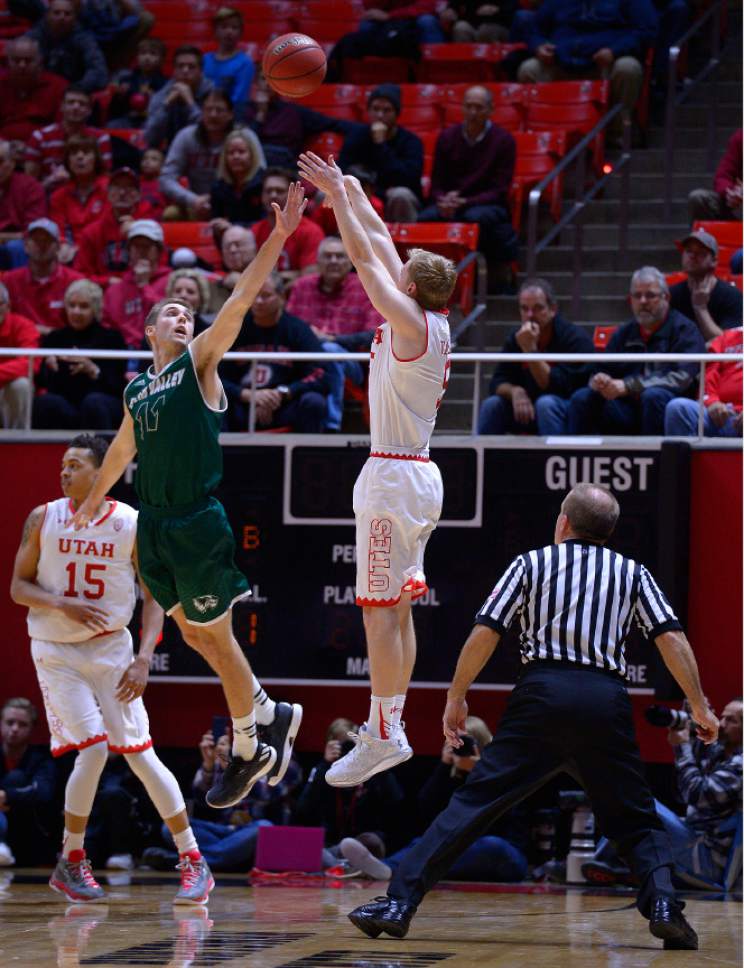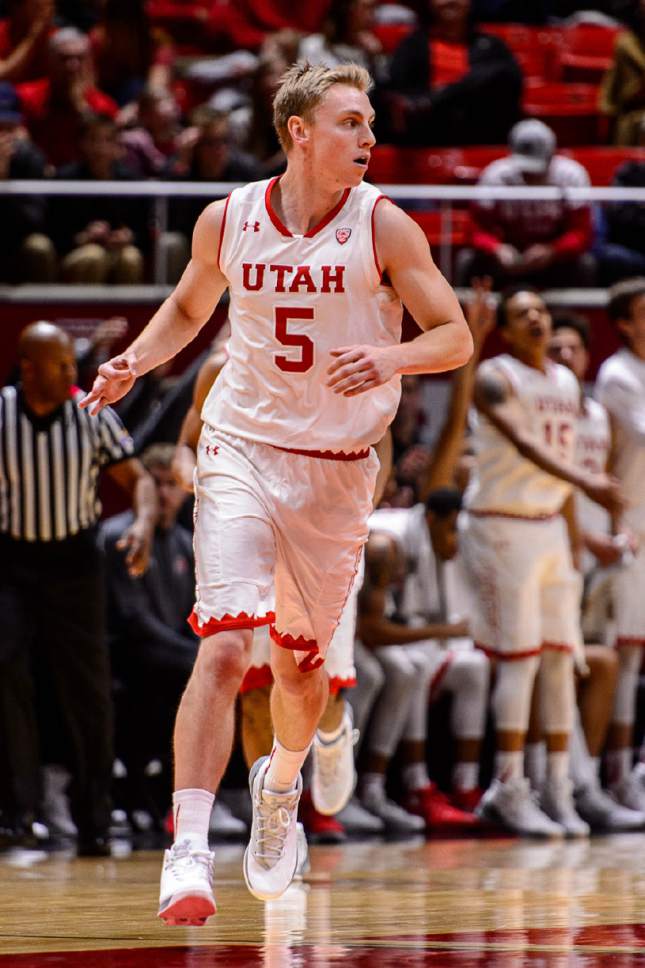This is an archived article that was published on sltrib.com in 2017, and information in the article may be outdated. It is provided only for personal research purposes and may not be reprinted.
That first shot tells him a lot, Parker Van Dyke says. It's the omen of a good night — or a bad one.
In his last 13 games out of the starting lineup, the sophomore guard has often struggled to drain that initial look. But last week, he hit both his first shots— 3-pointers — against Oregon (8 points) and Oregon State (11 points), leading to solid evenings ahead.
"Coming off the bench, when you hit your first shot, it really helps," he said. "It gets you in a rhythm and gives you confidence. The game just becomes a lot easier when you feel a rhythm coming."
Utah (15-6, 6-3) hopes that Van Dyke is finding a rhythm for the season and finally getting a hang for being a sub.
He started the first seven games of the season, averaging 7.4 points per game and scoring in double figures four times. But since coming off the bench, he's gone scoreless eight times.
That trend seemed to pivot last week, when Van Dyke made an impact in the two games at the Huntsman Center. Coach Larry Krystkowiak said the Utes weren't just riding the hot hand: Van Dyke has consistently shown an energy in practice that the coaches have wanted to utilize. He repaid their faith with 19 points and five assists in his combined 38 minutes.
"I see a little bit of confidence on his part and certainty about what he's doing," Krystkowiak said. "Parker's in a good way. We talk about guys who are energy givers. You walk into a practice session, and Parker's ready to give it to you."
He also cited Van Dyke as one of the best communicators on the team, a problem considering that "half our team goes mute." Add his communication and defensive energy to his shooting streak (11 for 18 in his last four games), he's become a valuable bench player.
From his struggles coming off the bench, Van Dyke said he's learned not to let his recent run change how he prepares.
"Our coaches do a great job every day of getting us to be consistent in everything we do and being consistent in bringing focus and energy regardless of how it's going," he said. "That's what I've been focusing on. Regardless of how my role has changed, I just try to be consistent in my play, my effort and my energy."
Foul caution remains high
Junior David Collette hasn't played as few minutes in any start this year as he did Saturday. The big reason: Foul trouble.
With two fouls by the 10-minute mark, Collette only played 8 minutes of the first half, despite scoring the first six points of Utah's win over Oregon State. There's differing opinions on the strategy of sitting players with two fouls, with some analysts arguing that two early, quick fouls can register as an anomaly that will even out over the course of a game — a player should play through them.
But experience guides Krystkowiak's decision-making on the issue, and one particular game: In the 2015 Sweet 16 against Duke, when Delon Wright picked up his third foul before halftime. Krystkowiak is haunted by the what-ifs of that scenario.
"Just simple math, when you get two fouls in the first half, you can't afford to have three," he said. "I thought Delon, if anybody, could play without fouling. Come to find out he didn't foul, but they called him for his third anyway."
Krystkowiak said allowing a player to get three fouls before the half not only dictates the final minutes of the first half, but keeps a team from getting out to an assertive start in the second half as well.
Of course Krystkowiak would like the entire scenario to be a non-issue with one of his favored suggestions for a rule tweak: six personal fouls instead of five. With 17 fouls per game, Utah ranks in the top 60 nationally among the least-fouling teams, but nevertheless, he thinks that too often, fouls keep the stars from being on the floor. While some have argued six fouls would make the game more physical, Krystkowiak said it would empower referees to enforce fouls while also giving players a little extra leeway when a ticky-tack foul is called.
"Somebody needs to tell me what other sport on the planet sits the best players out," he said. "Even if it were a perfect world and you knew they were fouls, I think it's a bad rule."
Free throws get special attention
In Monday's practice, Larry Krystkowiak set up a drill: The team was split in half to shoot free throws. One half shot 80 percent. One half shot 65 percent. The latter group ran.
What group was Collette in? "The one that shot 65 percent," he said with a sheepish grin.
Utah's free throws have been arguably the most inconsistent shots the team takes: At just 68.2 percent, Utah is ninth in the Pac-12 and No. 214 in the country on the line. In conference play, that rate has sunk to 60.7 percent.
Krystkowiak said the team is doing more in practice to address free throw shooting. When the team repeated the drill, the two groups tied with a 26 for 30 mark. But in the end it will likely require some extra-curricular commitment from players to bring the team's average up.
"It's like hitting range balls: If you want to be a decent golfer, you gotta go out there and get a feel for it," he said. "You hope that your players are putting themselves in a position to come in here and shoot 50 on their own."
Twitter: @kylegoon —
Utah at California
P Thursday, 7 p.m.
TV • Pac-12 Network















